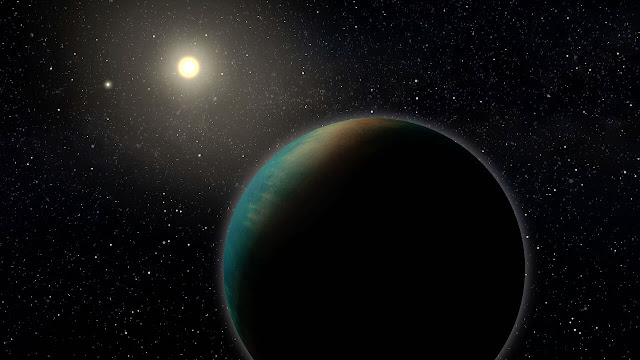In the vast expanse of the cosmos, the pursuit of extraterrestrial life has been a quest that has captivated the human imagination for centuries.
Now, on the horizon of our knowledge, a profound discovery has been made that might take us one step closer to unlocking the mysteries of life beyond Earth. Situated within the depths of the Leo constellation, approximately 120 light-years from our planet, K2-18 b, a 'super Earth' more than eight times the size of our own, has emerged as a celestial gem within the habitable zone of its cool dwarf star. What truly distinguishes this colossal exoplanet is not only its hydrogen-rich atmosphere and vast oceans of water but, remarkably, the presence of a gas that is uniquely associated with life.
The Astonishing Revelation
Dimethyl sulphide (DMS), a compound composed of carbon, hydrogen, and sulphur atoms, is the extraordinary gas that has stirred the scientific community's imagination. On Earth, DMS is a product of life, primarily emitted by phytoplankton in marine environments. This revelation on K2-18 b is akin to discovering a celestial fingerprint, a signature of life itself, in the distant reaches of the universe.
This finding prompts a profound question: Could K2-18 b be a cradle of alien life, nestled among the stars, within our cosmic neighborhood?
Hycean Worlds: The Crucible of Possibility
K2-18 b belongs to the intriguing class of exoplanets known as 'Hycean' worlds. These planets, although often larger and hotter than Earth, harbor the crucial ingredients for life. They possess extensive oceans capable of sustaining microbial life forms, analogous to those found in the extreme aquatic environments on Earth. Furthermore, Hycean worlds extend the boundaries of the habitable zone, making them potential havens for life even beyond the typical Goldilocks zone occupied by Earth-like planets.
The James Webb Space Telescope: Illuminating the Cosmic Enigma
As we stand on the cusp of this momentous discovery, the next crucial step involves further investigation. The James Webb Space Telescope, a monumental achievement in astronomical instrumentation, is poised to enter the scene. This $10 billion marvel can analyze the chemical composition of distant planets by capturing the light from their host stars as it traverses their atmospheres en route to Earth. This unique ability enables the detection of specific gases, such as DMS, which leave distinct imprints on the spectrum of light.
While the discovery of DMS on K2-18 b is tantalizing, further observations by the James Webb Space Telescope are imperative to confirm its presence conclusively. If validated, K2-18 b could ascend to the ranks of the most promising worlds for potential extraterrestrial life, alongside celestial neighbors like Mars and the icy moons of Jupiter and Saturn.
The Ongoing Quest
However, the presence of DMS, though a remarkable indicator, is not definitive proof of alien life. Carbon dioxide and methane, also detected in significant quantities in K2-18 b's atmosphere, can be produced through inorganic processes. Thus, the tantalizing question remains: Could K2-18 b indeed be teeming with life, or are these gases the result of natural, non-biological processes?
The journey of discovery continues, as scientists eagerly await the invaluable insights that the James Webb Space Telescope promises to unveil. In the realm of exoplanetary science, this revelation is a milestone, broadening our horizons and encouraging us to explore new frontiers in the search for life beyond Earth.
As we embark on this cosmic odyssey, we stand at the precipice of a new era of understanding, where the boundaries of possibility are expanded, and the question of whether we are alone in the universe takes center stage. K2-18 b, a 'Hycean' world adorned with the enigmatic presence of DMS, beckons us to delve deeper into the cosmic tapestry, where the threads of life's existence may be woven across the stars.
Hycean Planets That 'Could' Contain Alien Life
| Name | Mass (x Earth) | Radius (x Earth) | Temperature (K) | Temperature (F) |
|---|---|---|---|---|
| K2-18 b | 8.63 | 2.51 | 250 | -9.67 |
| K2-3 c | 2.14 | 1.74 | 286 | 55.13 |
| TOI-1266 c | 2.2 | 1.56 | 291 | 64.13 |
| TOI-732 c | 6.29 | 2.42 | 305 | 89.33 |
| TOI-270 d | 4.78 | 2.01 | 327 | 128.93 |
| TOI-175 d | 2.31 | 1.57 | 341 | 154.13 |
| TOI-776 c | 5.3 | 2.02 | 350 | 170.33 |
| LTT 1445 A b | 2.2 | 1.38 | 367 | 200.93 |
| K2-3 b | 6.48 | 2.12 | 384 | 231.53 |
| TOI-270 c | 6.14 | 2.33 | 413 | 283.73 |
| TOI-776 b | 4 | 1.85 | 434 | 321.53 |
K2-18 b, in addition to being classified as a 'super Earth,' also falls under the category of a 'sub-Neptune' planet. These intriguing celestial bodies, though absent from our solar system, exhibit distinct characteristics that make them an enigmatic subject of study.
The Complex Realm of Sub-Neptunes
Sub-Neptunes, characterized by a smaller radius than the outermost ice giant in our solar system, remain a realm of cosmic mystery. These distant cousins of Earth beckon us with their unique atmospheres, even as their distance presents challenges to our understanding. Their atmospheres remain the subject of debate among astronomers, and the nature of these enigmatic worlds continues to elude complete comprehension.
K2-18 b's colossal size, boasting a radius 2.6 times that of Earth, conceals a rich tapestry of mysteries. Its interior likely harbors a substantial mantle of high-pressure ice, reminiscent of Neptune, all within the embrace of a thinner hydrogen-rich atmosphere and an oceanic surface.
As we navigate the cosmic seas of knowledge, K2-18 b stands as a testament to the boundless wonders of the universe. The presence of DMS on this 'Hycean' world is a revelation that ignites the flames of curiosity and fuels our determination to explore the cosmos.

